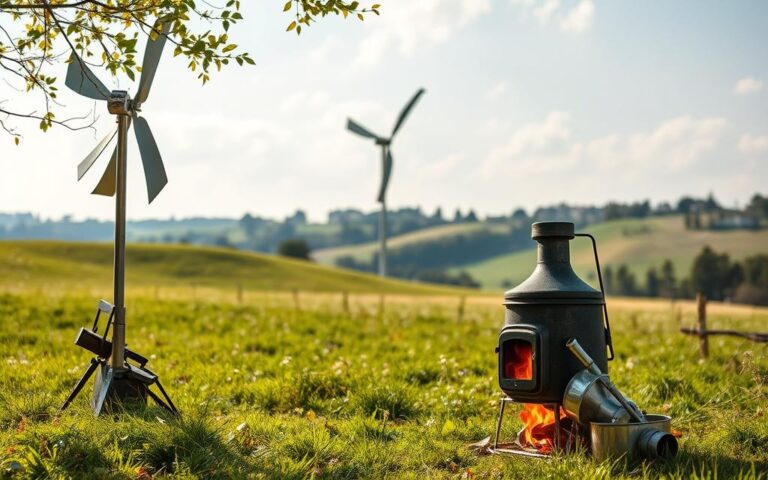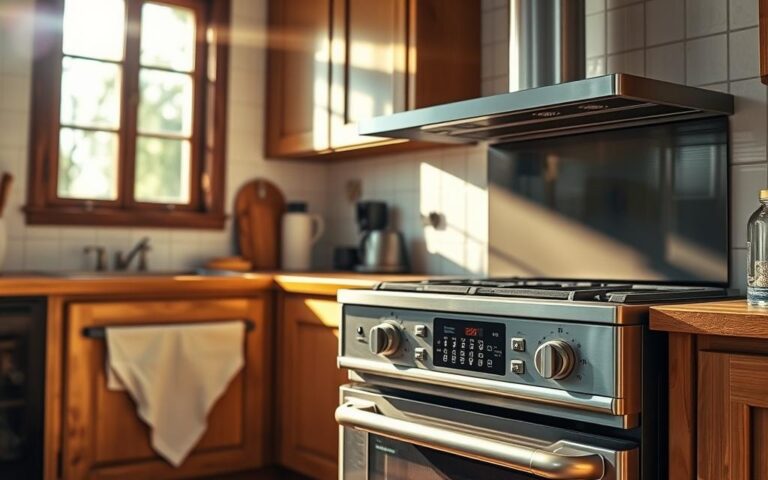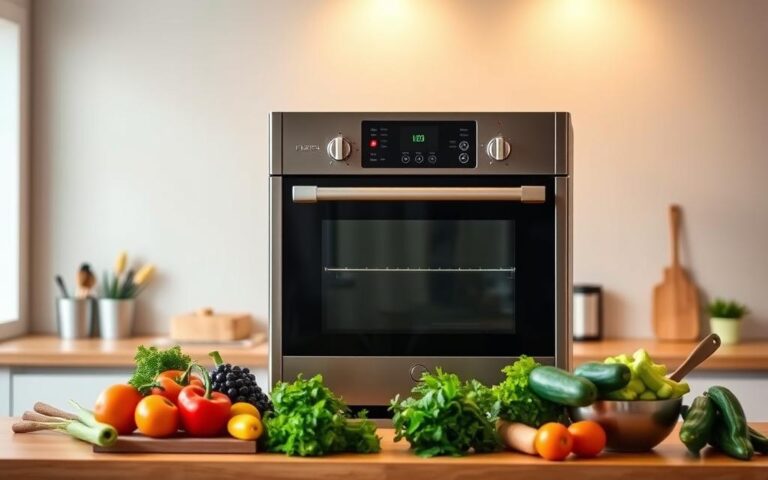
A small stream can power an entire home. Micro-hydro power offers a renewable energy solution for homeowners with running water. It’s an untapped resource waiting to be harnessed.
Micro-hydro generators turn flowing water into clean electricity. These small-scale systems work well on residential properties. They provide an innovative way to produce personal energy.
Hydro power is a promising alternative energy technology. It helps reduce carbon footprints and generates independent electricity. Homeowners with streams or small rivers can create their own power systems.
This guide covers designing, installing, and maintaining a micro-hydro generator. You’ll learn how to make renewable energy work for you. It’s easier than you might think to go green.
What is a Micro-Hydro Generator?
Small-scale hydropower is a promising solution for sustainable electricity generation. Micro-hydro generators harness water’s natural power on a compact scale. These systems offer an innovative approach to renewable energy.
Micro-hydro generators turn flowing water’s energy into electrical power. They work well in remote and rural locations. Unlike large dams, these systems have minimal environmental impact.
Definition and Concept
A micro-hydro generator produces 5 to 100 kilowatts of electricity. It’s a small-scale hydropower system with unique features.
- Minimal water diversion requirements
- Low environmental impact
- Adaptable to various water flow conditions
- Suitable for individual homes or small communities
Historical Context
“Water wheels have powered human civilization for centuries, and micro-hydro generators are the modern evolution of this ancient technology.” – Energy Innovation Research Center
Water-powered systems have existed since ancient times. The shift to electrical generation was a big leap in small-scale hydropower. This change marked a significant technological breakthrough.
Applications in Modern Energy Production
Small-scale hydropower systems have many uses across different sectors. They’re versatile and increasingly popular for decentralized renewable energy production.
| Sector | Application | Power Output |
|---|---|---|
| Residential | Off-grid Home Power | 5-25 kW |
| Agricultural | Irrigation System Power | 25-50 kW |
| Remote Communities | Local Electricity Generation | 50-100 kW |
Benefits of Micro-Hydro Power
Micro-hydro power offers eco-friendly electricity for homes and communities. This green energy solution provides sustainable power alternatives. It’s a game-changer in renewable energy.
Micro-hydro systems stand out in clean power generation. They harness flowing water’s energy with minimal environmental impact. These compact systems are evolving renewable energy technology.
Sustainable Energy Source
Micro-hydro generators provide consistent, reliable green energy. They can generate electricity 24/7, unlike solar or wind power. This ensures steady power for homes and small communities.
- Continuous power generation
- Minimal maintenance requirements
- Predictable energy output
Low Environmental Impact
Micro-hydro systems produce fewer carbon emissions than traditional power sources. They use natural water flow without major landscape changes. This technology is truly eco-friendly.
| Environmental Factor | Micro-Hydro Impact | Fossil Fuel Impact |
|---|---|---|
| Carbon Emissions | Near Zero | High |
| Water Usage | Minimal Disruption | Significant Consumption |
| Ecosystem Interference | Low | Substantial |
Cost-Effectiveness Over Time
Micro-hydro systems offer long-term financial benefits despite high initial costs. Homeowners can expect lower electricity bills over time. They might even earn money by generating excess energy.
“Micro-hydro power transforms water’s potential energy into an economical and sustainable electricity solution.” – Renewable Energy Expert
Types of Micro-Hydro Generators
Micro-hydro generators offer varied solutions for off-grid power. They come in different designs for various water sources and energy needs. Homeowners can choose the best approach for their environment.
Micro-hydro power systems have three main types. Each type has its own features and uses.
- Run-of-river systems
- Reservoir-based systems
- Pumped storage systems
Run-of-River Systems
Run-of-river systems are the simplest micro-hydro setup. They use water’s natural flow without storing it. These generators work best in streams with steady water movement.
They turn flowing water’s energy into electrical power. This provides a green power solution for rural areas.
Reservoir-Based Systems
Reservoir-based systems store water in a tank or dam. This allows for more controlled power generation. They can make electricity even when water flow is low.
Farmers and remote property owners often choose these systems. They provide reliable energy output.
Pumped Storage Systems
Pumped storage systems are the most advanced micro-hydro tech. They use two water reservoirs at different heights. Water is pumped between them to store and make electricity.
When electricity demand peaks, water flows from the higher reservoir. It goes through turbines, creating instant power.
Choosing the right micro-hydro generator depends on local water and land. Energy needs also matter. Each system offers unique benefits for green energy production.
Essential Components of a System
Water turbine systems need key parts to turn flowing water into sustainable power. These components change natural energy into usable electricity for off-grid or extra power.
Each part plays a crucial role in this process. Understanding these elements is vital for designing a successful system.
Micro-hydro power systems use three main components to generate electricity efficiently. These are water turbine mechanisms, electrical generators, and advanced control systems.
- Water turbine mechanisms
- Electrical generators
- Advanced control systems
Water Turbines: The Energy Conversion Engine
Water turbines are the heart of micro-hydro systems. They change the energy of flowing water into mechanical rotational energy.
Different turbine designs exist for various water flow conditions. These designs adapt to specific site requirements.
Generators: Transforming Mechanical Motion
Electrical generators turn the turbine’s rotational movement into electrical power. Synchronous and induction generators are common in micro-hydro systems.
Each type of generator offers unique benefits for sustainable power production.
Control Systems: Ensuring Optimal Performance
Control systems watch over the entire micro-hydro power generation process. They protect equipment and optimize power output.
These smart systems also manage electrical load distribution. This ensures consistent and reliable sustainable power generation.
Site Assessment for Micro-Hydro Projects
A successful micro-hydro generator needs careful site evaluation. Understanding your water resource is key for an effective hydro power system. This ensures sustainable energy generation for your property.
Property owners must conduct a thorough site assessment before installation. This process determines the project’s feasibility and potential power output. It’s crucial for a successful renewable energy project.
Evaluating Water Flow Characteristics
Water flow assessment involves several key measurements:
- Stream velocity measurements
- Water volume calculations
- Seasonal flow variations
- Elevation drop assessment
Environmental Impact Considerations
Responsible hydro power development requires thorough environmental evaluation. Critical factors include:
- Aquatic ecosystem protection
- Wildlife habitat preservation
- Minimal stream disruption
- Sediment and water quality maintenance
“A successful micro-hydro generator harmonizes technological innovation with ecological preservation.” – Renewable Energy Experts
Legal and Regulatory Compliance
Navigating legal requirements is essential for micro-hydro project implementation. Potential considerations include:
- Water rights permissions
- Local zoning regulations
- Environmental permits
- Grid interconnection agreements
Professional consultation with local authorities and environmental experts can streamline the site assessment process for your micro-hydro generator project.
Design Considerations for Efficiency
Efficient small-scale hydropower systems need careful planning and precise calculations. Understanding key design parameters can help maximize micro-hydro generator performance. Renewable energy enthusiasts can benefit from this knowledge.
Three critical design elements are essential for optimizing small-scale hydropower systems. These include generator capacity, pipe configuration, and power output estimation techniques.
- Generator capacity matching water resources
- Pipe configuration and hydraulic efficiency
- Power output estimation techniques
Sizing Your Generator
The right generator size impacts your renewable energy system’s effectiveness. Important factors include available water flow rate and total vertical drop (head).
Consider your expected power consumption needs when selecting a generator. This ensures your system meets your energy requirements.
- Available water flow rate
- Total vertical drop (head)
- Expected power consumption needs
Pipe Sizing and Layout
Proper pipe sizing reduces energy losses in small-scale hydropower installations. Hydraulic efficiency depends on pipe diameter, material, and routing.
Smooth pipe transitions and minimal bends help maintain optimal water flow. These factors contribute to the overall system efficiency.
Power Generation Calculations
Potential power output calculations involve water flow, head height, and generator efficiency. The basic formula multiplies water flow rate, gravity, total head, and system efficiency.
Power (Watts) = Flow Rate × Gravity × Total Head × System Efficiency
DIY Installation Process
Micro-hydro generators offer eco-friendly electricity. These off-grid power solutions need careful planning and precise execution. Technical skills and strategy are crucial for installation.
Essential Tools and Equipment
Gather these tools for your micro-hydro installation:
- Pipe wrench and adjustable spanner
- Electrical multimeter
- Waterproof sealants
- Protective waterproof clothing
- Safety harness and non-slip footwear
- Power drill with various drill bits
- Water flow measurement equipment
Step-by-Step Installation Guide
Installing a micro-hydro system needs careful attention. Follow these key steps:
- Conduct thorough site assessment
- Measure water flow and head pressure
- Select appropriate turbine type
- Install water intake structure
- Position pipeline and generator
- Connect electrical components
- Test system performance
Safety Precautions
Safety is crucial when working with water-based electrical systems. Always prioritize personal protection and professional guidance. Take these key safety measures:
- Wear electrical-resistant gloves
- Ensure proper grounding of electrical components
- Work with a certified electrician
- Check local regulations and permits
- Implement waterproof electrical connections
“A well-planned micro-hydro installation can provide sustainable, eco-friendly electricity for years to come.” – Renewable Energy Expert
Maintenance and Upkeep
Careful maintenance of water turbines ensures sustainable power generation for years. Proper upkeep keeps your micro-hydro system running efficiently. It also maximizes the potential energy output of your system.
Regular checks prevent unexpected breakdowns and extend your system’s life. A consistent inspection routine saves time and money. It’s a smart investment for your sustainable power system.
Routine Inspections
A comprehensive maintenance schedule should include:
- Monthly visual inspections of water turbine components
- Quarterly cleaning of intake screens and water channels
- Biannual lubrication of moving parts
- Annual comprehensive system check
Troubleshooting Common Issues
Water turbine systems can face several typical problems. These issues need quick attention:
- Sediment buildup – Clean intake screens regularly
- Check for alignment issues in turbine mechanisms
- Monitor electrical connections for corrosion
- Inspect pipe systems for potential leaks
Extending Your System’s Life
To boost your system’s longevity, try these strategies:
- Protect equipment from extreme weather conditions
- Use high-quality protective coatings
- Replace worn components proactively
- Keep detailed maintenance records
Regular maintenance keeps your micro-hydro system generating clean energy efficiently. This investment ensures your system’s long-term performance. It’s key to sustainable power for years to come.
Financing Your Micro-Hydro Project
Green energy investments through hydro power need careful financial planning. Micro-hydro systems offer a chance to generate electricity and cut long-term energy costs. These systems are exciting for renewable energy fans.
Initial Investment Breakdown
Micro-hydro project costs vary based on site conditions and system complexity. Here are typical expenses:
- Equipment costs: $5,000 – $25,000
- Installation expenses: $3,000 – $15,000
- Site preparation: $2,000 – $10,000
- Electrical system integration: $1,500 – $5,000
Federal and State Incentives
Hydro power projects can get significant financial support. Here are key incentives:
| Incentive Type | Potential Savings |
|---|---|
| Federal Tax Credit | 30% of total project cost |
| State Renewable Energy Grants | Up to $10,000 |
| Utility Rebate Programs | $0.10 – $0.50 per kWh generated |
Return on Investment Analysis
A good micro-hydro system can bring big long-term financial benefits. Most homeowners get their money back in 5-10 years through:
- Reduced electricity bills
- Potential energy credits
- Increased property value
Micro-hydro power is a smart choice for sustainable home energy. It supports renewable energy growth and can boost your finances.
Research and planning help maximize returns on your green energy investment. This approach ensures both financial and environmental benefits.
Real-World Case Studies
Micro-hydro generators show great promise in run-of-river systems across the United States. These case studies reveal how small-scale hydroelectric tech transforms various environments. They offer valuable insights into the potential and challenges of these systems.

Success Stories from Rural Communities
Oregon’s mountain communities have embraced micro-hydro generators for sustainable energy. The Clackamas County project is a standout example. Their run-of-river system provides steady electricity to local residents.
- Reduced energy costs by 60%
- Minimal environmental disruption
- Reliable power generation throughout the year
Learning from Challenging Implementations
Not all micro-hydro projects succeed immediately. Some important lessons came from projects that faced major hurdles:
- Thorough site assessment is crucial
- Water flow consistency determines system viability
- Local regulatory compliance cannot be overlooked
Innovative Applications Beyond Traditional Power
Micro-hydro generators are expanding beyond basic electricity production. Farms, research stations, and remote facilities now use these systems for special purposes. This shows how adaptable renewable energy tech can be.
Small streams can power big dreams of sustainable energy solutions.
These case studies highlight micro-hydro tech’s potential to change local energy production. They prove that sustainable innovation can come from even the smallest water sources.
Future of Micro-Hydro Energy
Small-scale hydropower is emerging as a promising solution for sustainable electricity generation. Technological innovations are rapidly transforming micro-hydro systems. These advancements make them more efficient and accessible to communities across the United States.
Cutting-edge developments in turbine design and digital control systems are enhancing small-scale hydropower. Advanced materials enable more precise energy capture from minimal water flows. This expands renewable energy potential in diverse geographic locations.
Technological Advancements
Researchers at Stanford and MIT are exploring novel approaches to micro-hydro technology. Compact modular systems and improved generator efficiency create new opportunities for community-based projects. These innovations promise to reduce costs and increase performance of small-scale hydropower installations.
Policy and Regulation Trends
Federal and state policies increasingly support micro-hydro development as part of broader renewable energy strategies. Incentive programs make it attractive for individuals and communities to invest in small-scale hydropower. The U.S. Department of Energy funds research in this critical sector of sustainable energy infrastructure.
Community Involvement in Renewable Energy
Local communities are becoming key drivers of micro-hydro adoption. Grassroots initiatives demonstrate how small-scale hydropower can enhance energy resilience in various settings. More communities recognize micro-hydro as a viable and environmentally friendly energy alternative.
FAQ
What is a micro-hydro generator?
A micro-hydro generator is a small-scale hydroelectric power system. It turns flowing water into electricity. These compact systems generate 5 to 100 kilowatts of power, perfect for homes or small communities.
How much water flow do I need for a micro-hydro system?
You need at least 1.5 gallons per minute of water flow. A vertical drop of 3-4 feet is also necessary. More water flow and drop means more electricity generated.
Professional assessments can determine your water source’s potential.
Are micro-hydro generators environmentally friendly?
Yes, micro-hydro generators are very eco-friendly. They produce clean, renewable energy with little environmental impact. These systems create no direct greenhouse gas emissions.
When properly designed, they cause minimal disruption to local ecosystems.
What are the initial costs for a micro-hydro system?
Initial costs range from $10,000 to $50,000. The price depends on system complexity, site needs, and power generation capacity.
Many owners recover costs through energy savings and tax incentives within 5-10 years.
Can I install a micro-hydro generator myself?
Some DIY enthusiasts can handle parts of the installation. However, it’s best to work with professional hydropower engineers.
Experts are crucial for design, site assessment, and critical components. Electrical and water system knowledge ensures safe, efficient implementation.
How reliable is micro-hydro power generation?
Micro-hydro systems are very reliable compared to solar or wind power. Water flow is typically more consistent than other renewable sources.
A steady stream can provide round-the-clock electricity with proper system design.
What maintenance do micro-hydro generators require?
Regular maintenance includes quarterly inspections and annual turbine checks. Cleaning debris screens and lubricating moving parts are also important.
Well-designed systems need minimal care. They can operate efficiently for 20-25 years with proper maintenance.
Are there government incentives for micro-hydro installations?
Yes, various federal and state incentives exist. These include tax credits, grants, and low-interest loans for renewable energy projects.
The Investment Tax Credit and state programs can significantly reduce installation costs.
What types of micro-hydro systems are available?
The main types are run-of-river, reservoir-based, and pumped storage systems. Each has unique benefits depending on terrain and water availability.
Your energy needs also play a role in choosing the right system.
Can micro-hydro generators work during drought conditions?
Performance depends on water flow. During severe droughts, power generation may decrease or stop temporarily.
Proper site selection and water flow assessment can help. Combining with other renewable sources might also solve this challenge.



